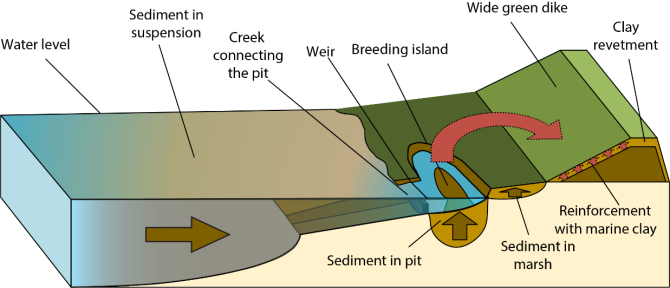
News
How plants and pits contribute to adapting dikes to sea-level rise
To prepare the Dutch coast for sea-level rise, innovative nature-based dike concepts are explored. One such example is the Wide Green Dike pilot in the Dollard. In this concept, a gently-sloping grass dike is reinforced with clay gathered from pits in the marshy foreshore. In our latest paper, we explored how this system functions under different sea-level rise scenarios. Not only is it feasible for dikes to be reinforced in this scheme, the effectiveness of clay pits increases as sea-level rise accelerates.
Up north in the Dutch Wadden sea in the spring of 2018 a new innovative pilot was launched in what looks like an unimpressive field of mud, weeds and low shrubs. A four hectare large pit was excavated with a small island remaining in the middle. However, these humble salt marshes and pit may be key in tackling the two most pressing threats of the region at once: deteriorating water quality and sea-level rise.
An old idea for new problems
The Dollard is a small bay in the Ems estuary at the Dutch, German border. It has a long history of land reclamation going back to the Middle Ages. As early as the 17th century locals understood how to work with nature to create new land for farming and grazing. This was achieved by the construction and upkeep of a pattern of low clay-built groynes and a dense drainage network. In doing so, the ideal conditions for vegetation to establish and grow were created. Over time, these plants trap the small clay particles suspended in the water and raise the land over time.
After land reclamation works were discontinued in the last century, the space for suspended clay to be captured has diminished. The water in estuary became more and more turbid over time and the suspended sediment blocks sunlight from reaching the creatures in the sea. The Wide Green Dike project initiated by Waterboard Hunze & Aa’s and supported by the Highwater Protection Program aims to combat this issue while improving flood safety. By constructing the pit, the ability of the marsh to trap clay out of the water is enhanced and as a bonus, the captured clay can be used for raising the dikes against sea-level rise.

Adapting to the future
In the study by Marijnissen, et al., sea-level rise scenarios were modelled for the Wide Green Dike system to study its potential as a climate change adaptation measure. In the present the pit is already filling up with clay rapidly and it is projected to be refilled within 22 years. Not only that, as the sea-level rise accelerates the pit is flooded more frequently, allowing it to trap clay more often and thus fill up faster. There is a caveat though. As long as the sea-level rise doesn’t accelerate to much the pits and marshes can keep sea-level rise in check. However, in the highest sea-level rise scenario (+1.9 m by 2100) the sea-level rises to fast for the marsh to keep up. And as the marsh drowns and the foreshore deepens, the dike will need to be reinforced even more to compensate. Thus, preventing the marshes from drowning in high sea-level rise scenarios is necessary to keep the Wide Green Dike system functioning.